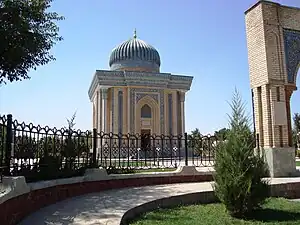Yusuf Hamadani | |
|---|---|
 Shrine of Yusuf Hamadani | |
| Personal | |
| Born | 1048 or 1049 CE (440 AH) |
| Died | 1140 CE (618 AH) |
| Resting place | Bayramaly, Turkmenistan |
| Religion | Islam |
| Era | Islamic Golden Age |
| Region | Central Asia |
| Denomination | Sunni |
| Jurisprudence | first Shafi'i school, later Hanafi school |
| Main interest(s) | Sufism |
| Tariqa | Naqshbandi (Khwajagan) |
| Part of a series on Islam Sufism |
|---|
 |
|
|
Abū Yaʿqūb Yūsuf al-Hamadānī, best simply known as Yusuf Hamadani (born 1048 or 1049 / 440 AH - died 1140 / 535 AH), was a Persian[1] Sufi of the Middle Ages. He was the first of the group of Central Asian Sufi teachers known simply as Khwajagan (the Masters) of the Naqshbandi order. His shrine is at Merv, Turkmenistan.
Life
| Part of a series on Sunni Islam |
|---|
|
|
Born in Buzanjird near Hamadan in 1048 or 1049, he moved to Baghdad when he was eighteen years of age.[2] He studied the Shafi'i school of fiqh under the supervision of the master of his time, Shaykh Ibrahim ibn Ali ibn Yusuf al-Fairuzabadi. He kept association in Baghdad with the great scholar, Abu Ishaq al-Shirazi, who gave him greater deference than to any of his other students although he was the youngest. But he was a Hanafi Maturidi unlike his teachers.[3]
According to Ibn Khallikan, he began his religious career with the cultivation of the religious sciences, becoming both a respected scholar of hadith and fiqh and a popular preacher in Baghdad. He was so brilliant a jurisprudent that he became the Marja of his time for all scholars in that field. He was known in Baghdad, the center of Islamic knowledge, in Isfahan, Bukhara, Samarqand, Khwarazm, and throughout Central Asia.
Later he abandoned these pursuits, adopting an intensely ascetic way of life and travelled east, first settling in Herat and later in Merv, where his tomb is still reputed to exist. He became an ascetic and engaged in constant worship and mujahada (spiritual struggle), instructed by Shaykh Abu 'Ali al-Farmadhi. He associated with Shaykh Abdullah Ghuwayni and Shaykh Hasan Simnani. He named four khalifas or successors, a pattern that repeated itself for several succeeding generations of the Khwajagan, including Ahmad Yasawi and Khwaja Abdul Khaliq Gajadwani, the next link in the Naqshbandi silsila.
In popular culture
The Turkish television series Mavera: Hace Ahmed Yesevi (2021) is based on the life of poet Ahmad Yasawi (portrayed by the Turkish actor Korei Cezayirli), who was sent to Baghdad by his murshid (spiritual guide) Yusuf Hamadani.[4]
See also
References
- ↑ Soucek, Svat (2000). A History of Inner Asia. Cambridge University Press. p. 141. ISBN 978-0521657044.
Khwaja Yusuf was a Persian, and, as his nisba suggests, came from Hamadan.
- ↑ Algar 1983, pp. 395–396.
- ↑ Mansurov, Fatkhiddin; Badaruddi̇n, Faudzinaim Hj (December 2011), "Khawaja Yusuf Hemedani: The Inspirer of Two Major Sufi Tariqas", Harran Üniversitesi İlahiyat Fakültesi Dergisi (in Turkish), Harran University Theology Faculty Journal, 26 (26): 168
- ↑ Mavera: Hace Ahmed Yesevi (History), ES Film, 2021-04-12, retrieved 2022-12-27
Sources
- Abu Ya`qub Yusuf ibn Ayyab ibn Yusuf ibn al-Husayn al-Hamadani——May Allah Sanctify His Soul; https://web.archive.org/web/20120303111446/http://www.naqshbandi.org/chain/9.htm
- Algar, H. (1983). "ABU YAʿQUB HAMADĀNI". In Yarshater, Ehsan (ed.). Encyclopædia Iranica, Volume I/4: Abū Manṣūr Heravı̄–Adat. London and New York: Routledge & Kegan Paul. pp. 395–396. ISBN 978-0-71009-093-5.
- Omar Ali Shah (1998). The Rules or Secrets of the Naqshbandi Order. Tractus Books. ISBN 2-909347-09-5.
- John G. Bennett (1995). The Masters of Wisdom. Bennett Books. ISBN 1-881408-01-9.
Further reading
- Paul, Jürgen (2010). "Abū Yaʿqūb Yūsuf al-Hamadānī". In Fleet, Kate; Krämer, Gudrun; Matringe, Denis; Nawas, John; Rowson, Everett (eds.). Encyclopaedia of Islam (3rd ed.). Brill Online. ISSN 1873-9830.
